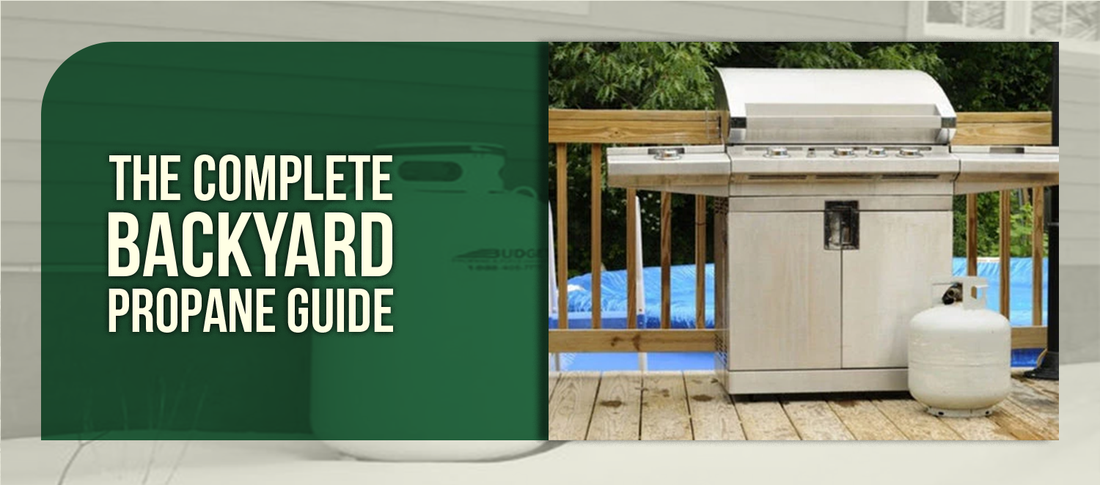
The Complete Backyard Propane Guide
Propane has become the backbone of modern outdoor living, powering everything from backyard grills to patio heaters, fire pits, and outdoor kitchens. Whether you're hosting weekend barbecues, creating cozy evening atmospheres, or preparing for camping adventures, understanding propane systems is essential for safe and efficient outdoor experiences.
This comprehensive guide will walk you through everything you need to know about propane tanks, from selecting the right size for your needs to proper maintenance and safety protocols. We'll cover the various applications, storage requirements, and practical tips that will help you make informed decisions for your backyard setup.

Understanding Propane Tank Sizes and Applications
Common Propane Tank Sizes for Backyard Use:
- 1 lb Disposable Cylinders - Perfect for portable camping stoves and small torches
- 5 lb Propane Tanks - Ideal for tabletop grills and small patio heaters
- 20 lb Propane Tanks - Standard size for most gas grills and medium outdoor appliances
- 30 lb Propane Tanks - Great for larger grills and extended outdoor cooking sessions
- 40 lb Propane Tanks - Perfect for substantial outdoor kitchens and commercial-style equipment
- 100 lb Propane Tanks - Best for whole-house heating systems and large outdoor installations
Choosing the Right Size for Your Needs
Selecting the appropriate propane tank size depends on your specific applications and usage patterns. For typical backyard grilling, a 20 lb tank provides approximately 18-20 hours of cooking time on medium heat. If you frequently entertain or have multiple propane appliances, consider larger tanks or multiple smaller ones for convenience and backup.
Essential Safety and Storage Guidelines
Proper Storage Practices
Always store propane tanks upright in well-ventilated outdoor areas, away from direct sunlight and heat sources. Never store tanks in enclosed spaces like garages, basements, or sheds. Maintain a minimum distance of 10 feet from doors, windows, and air intakes.
Temperature Considerations
Propane tanks should be stored in temperatures between -40°F and 120°F. In extremely cold weather, tank pressure may drop, affecting appliance performance. Conversely, high temperatures can increase pressure and trigger safety relief valves.

⚠️ Safety Reminder
Never attempt to repair or modify propane tanks yourself. Always use certified professionals for repairs and inspections. Check connections regularly for leaks using soapy water solution - bubbles indicate gas leaks that require immediate attention.
Maintenance and Care Instructions
Regular Maintenance Schedule
Monthly Inspections
Check valve connections, hoses, and fittings for wear, damage, or corrosion. Inspect the tank exterior for dents, rust, or other damage that could compromise safety.
Seasonal Preparation
Before peak usage seasons, test all connections and clean appliance components. Store tanks properly during off-seasons and consider professional inspections annually.
Connection Care
Keep threaded connections clean and apply appropriate thread sealant when needed. Replace worn or damaged hoses immediately to prevent dangerous gas leaks.
Tank Size |
Typical Applications |
Average Runtime |
Best For |
|---|---|---|---|
| 20 lb | Standard grills, fire pits | 18-20 hours | Regular backyard use |
| 30 lb | Large grills, patio heaters | 25-30 hours | Frequent entertaining |
| 40 lb | Outdoor kitchens, commercial equipment | 35-40 hours | Heavy-duty applications |
Maximizing Efficiency and Performance
Optimizing Your Setup
Proper regulator selection and hose routing can significantly impact performance and safety. Use only approved regulators designed for your specific tank size and appliance requirements. Ensure adequate ventilation around your equipment and maintain clear access to shut-off valves.
Weather Considerations
Wind guards and proper positioning can improve efficiency in outdoor conditions. During cold weather, consider tank warming techniques to maintain consistent pressure and performance.

Professional Installation and Services
While many propane applications are suitable for DIY installation, complex systems benefit from professional setup and certification. Licensed technicians can ensure proper sizing, installation, and compliance with local codes and regulations.
When to Call Professionals
Consider professional installation for permanent installations, large tank systems, or when connecting multiple appliances. Regular professional inspections can identify potential issues before they become safety hazards and help maintain optimal system performance.
Many suppliers offer comprehensive services including delivery, installation, maintenance, and emergency support. These services can provide peace of mind and ensure your propane systems operate safely and efficiently year-round.

Environmental Impact and Efficiency
Propane is considered one of the cleanest burning fossil fuels, producing fewer greenhouse gas emissions than many alternatives. Proper maintenance and efficient usage patterns can further reduce environmental impact while maximizing the value of your propane investment.
Eco-Friendly Propane Practices
Efficient Usage
Use appropriate flame settings for your cooking needs and maintain equipment in peak condition to minimize fuel consumption and maximize performance.
Proper Disposal
Always return empty tanks to certified exchange or refill locations. Never dispose of propane tanks in regular trash or recycling programs.





